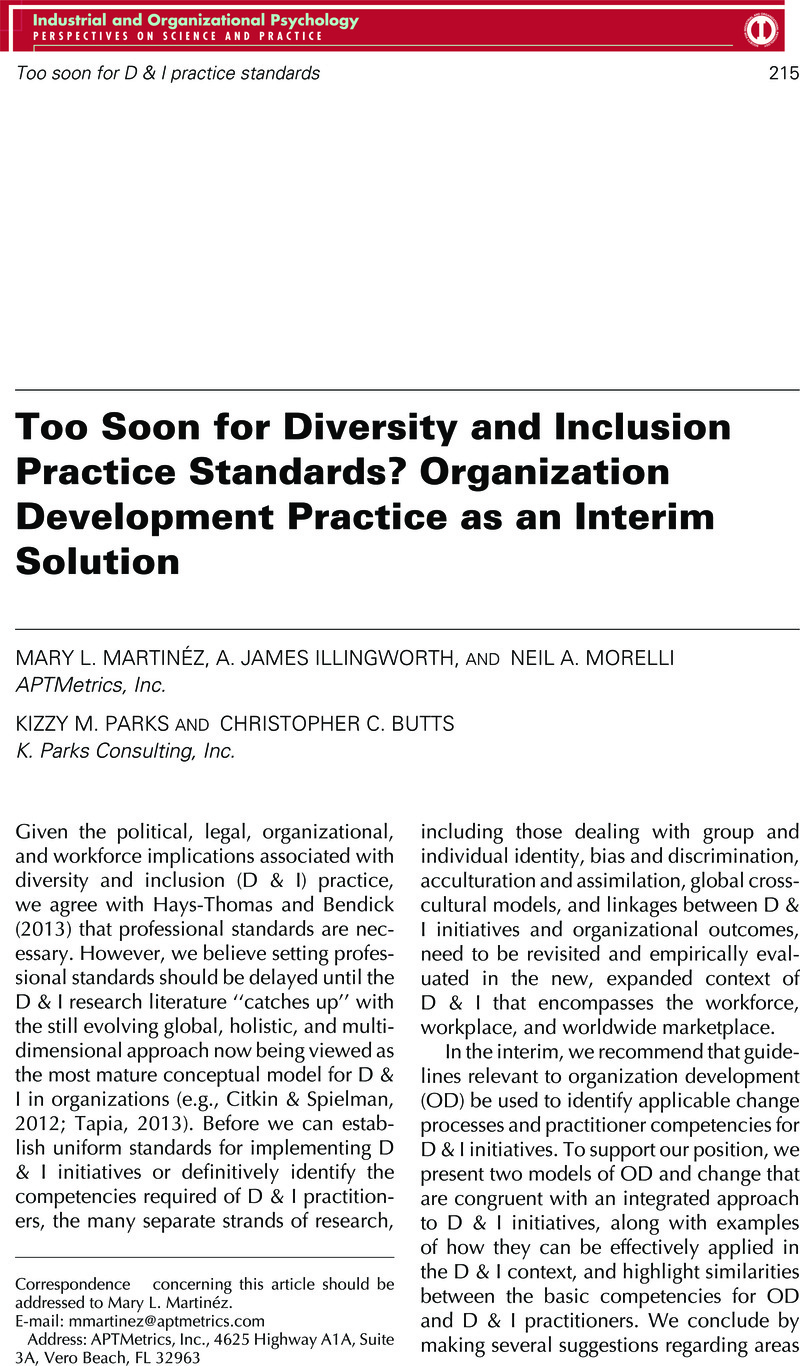No CrossRef data available.
Article contents
Too Soon for Diversity and Inclusion Practice Standards? Organization Development Practice as an Interim Solution
Published online by Cambridge University Press: 07 January 2015
Abstract
An abstract is not available for this content so a preview has been provided. Please use the Get access link above for information on how to access this content.

- Type
- Commentaries
- Information
- Copyright
- Copyright © Society for Industrial and Organizational Psychology 2013
References
Burke, W. W., & Litwin, G. H. (1992). A causal model of organizational performance and change. Journal of Management, 18(3), 523–545.Google Scholar
Citkin, F., & Spielman, L. (2012). Transformational diversity: Why and how intercultural competencies can help organizations to survive and thrive. Alexandria, VA: The Society for Human Resource Management.Google Scholar
Cornell University. (2013). Human capital development: Diversity management certificate. Retrieved from http://www.ilr.cornell.edu/hcd/certificates/dm/diversityManagement.htmlGoogle Scholar
Cummings, T. G., & Worley, C. G. (2009). Organization development and change (9th ed.). Mason, OH: South-Western Cengage Learning.Google Scholar
Georgetown University. (2013). Diversity and inclusion management. Retrieved from http://scs georgetown.edu/programs/59/master-of-professional-studies-in-diversity-and-inclusion-managementGoogle Scholar
Hays-Thomas, R., & Bendick, M. Jr. (2013). Professionalizing diversity and inclusion practice: Should voluntary standards be the chicken or the egg? Industrial and Organizational Psychology: Perspectives on Science and Practice, 6, 193–205.Google Scholar
Holvino, E., Ferdman, B. M., & Merrill-Sands, D. (2004). Creating and sustaining diversity and inclusion in organizations: Strategies and approaches. In Stockdale, M. S., & Crosby, F. J. (Eds.), The psychology and management of workplace diversity (pp. 245–276). Malden, MA: Blackwell.Google Scholar
Hubbard, E. (2012). The power of diversity ROI measurement alignment—Part 2. Retrieved from http://blog.diversity-executive.com/2012/12/14/the-power-of-diversity-roi-measurement-alignment-%E2%80%94-part-2/Google Scholar
Kalev, A., Dobbin, F., & Kelly, E. (2006). Best practices or best guesses? Assessing the efficacy of corporate affirmative action and diversity policies. American Sociological Review, 71, 589–617.CrossRefGoogle Scholar
Lahiri, I. (2008). Creating a competency model for diversity and inclusion practitioners. Retrieved from http://www.conference-board.org/publications/publicationdetail.cfm?publicationid=1478Google Scholar
Tannenbaum, B. (1995). Self-awareness: An essential element underlying consultant effectiveness. Journal of Organizational Change Management, 8(3), 85–86.Google Scholar
Tapia, A. T. (2013). The inclusion paradox: The Obama era and the transformation of global diversity (2nd ed.). United States of America: Author.Google Scholar
Thomas, K. M., & Plaut, V. C. (2008). The many faces of diversity resistance in the workplace. In Thomas, K. M. (Ed.), Diversity resistance in organizations (pp. 1–22). Mahwah, NJ: Erlbaum.Google Scholar
University of Houston. (2013). Center for diversity certification (CfDC): Professional development certificates & certification. Retrieved from http://centerfordiversity certification.com/ Diversity_Certifications.htmlGoogle Scholar
Worley, C. G., Rothwell, W. J., & Sullivan, R. L. (2005). Competencies of OD practitioners. In Rothwell, W. J., & Sullivan, R. L. (Eds.), Practicing organization development: A guide for consultants (pp. 135–163). San Francisco, CA: Pfeiffer.Google Scholar


